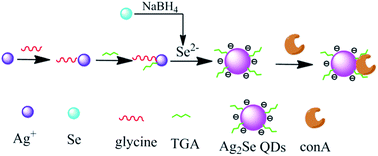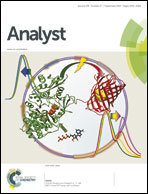Synthesis of water-soluble Ag2Se QDs as a novel resonance Rayleigh scattering sensor for highly sensitive and selective ConA detection
Abstract
Ag2Se quantum dots (QDs) have attracted a lot of interest due to their potential applications in biosensing and bioimaging. A strategy is presented that involves coupling of selenium powder reduction with the binding of silver ions, and thioglycollic acid (TGA) and glycine as stabilizers to obtain ultrasmall Ag2Se QDs at 85 °C in aqueous solution. This strategy avoids high temperatures, high pressures and organic solvents so that water-soluble 3 nm Ag2Se QDs can be directly obtained. The conjugation of ConA to TGA stabilized Ag2Se QDs by hydrogen bonds leads to the adsorption of ConA to Ag2Se QDs and forms the aggregation and leads to the generation of resonance Rayleigh scattering (RRS) as a readout signal for the sensing events. The reaction mechanism of Ag2Se QD RRS enhancement is studied in this work. The resulting RRS sensor enables the detection of ConA with limit of detection reaching 0.08 μg mL−1 concentration in a wide linear range from 0.27 μg mL−1 to 35 μg mL−1. The recovery of spiked ConA in human serum samples ranges from 94% to 106%. The relative standard deviation (RSD) for eleven replicate detections is 3.6%. Our results correlate many important experimental observations and will fuel the further growth of this field.


 Please wait while we load your content...
Please wait while we load your content...